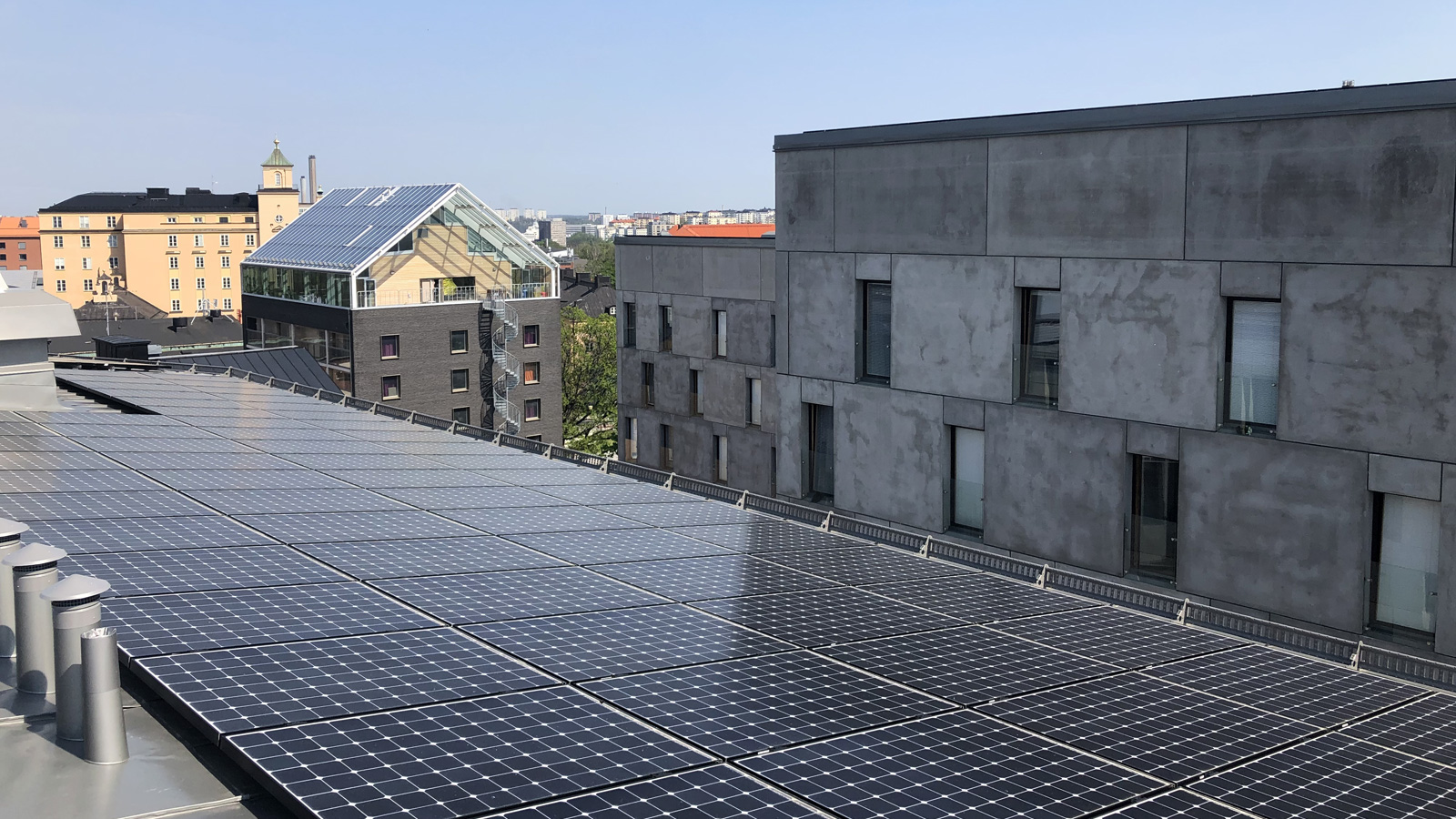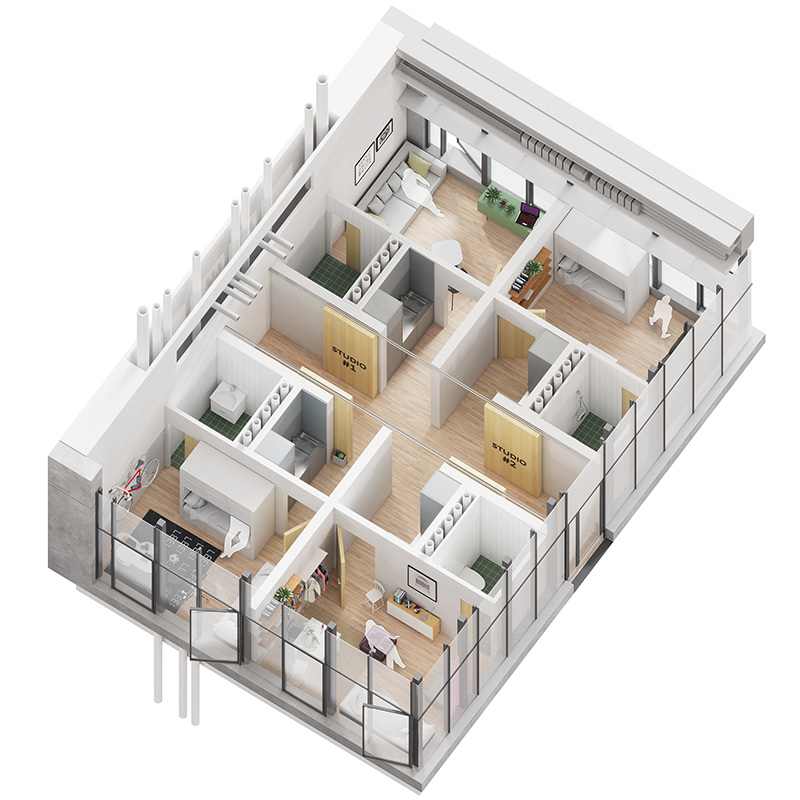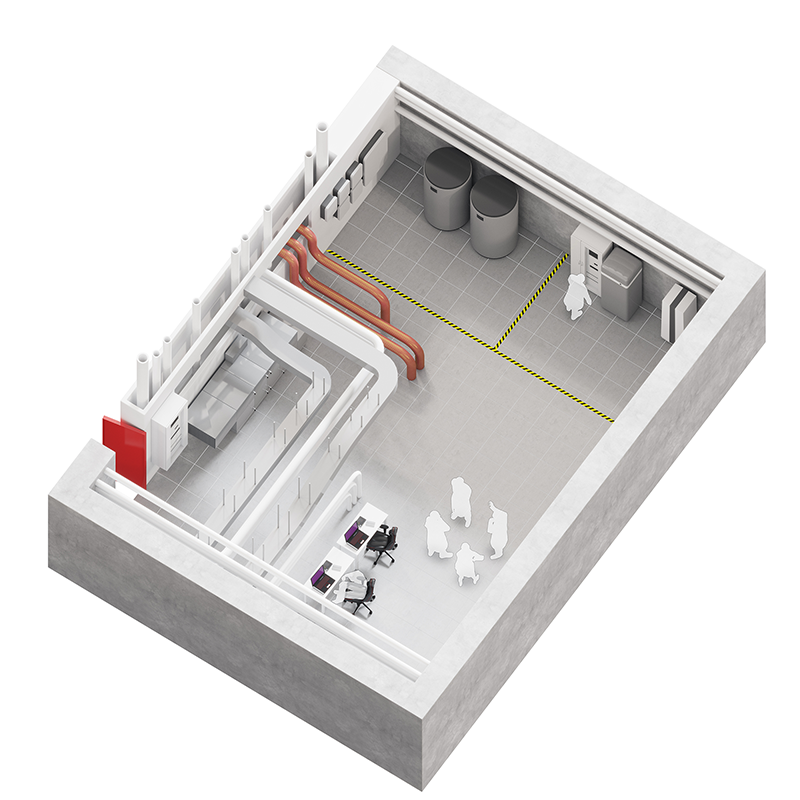Vision, Purpose and Goal
KTH Live-In Lab enables testing of products, services and methods in real buildings, which results in a well-founded basis for changing structures and rules, and increased use of new innovative technology. Tests in KTH Live-In Lab lead to accelerated innovation.

Vision
KTH Live-In Lab ensures that KTH becomes a sustainable campus and that Stockholm retains its leadership in sustainable urban development with a focus on digitization and smart cities. This is done by accelerating the pace of innovation in the construction and real-estate sectors, based on excellence in research, education and collaboration.
Purpose
KTH Live-In Lab is a platform for accelerated innovation in the real-estate sector, and for collaboration between academia and business. Most test beds in KTH Live-In Lab are operated in real environments for testing and researching new technologies and new methods.
The purpose of KTH Live-In Lab is to reduce the lead times between test/research results and market introduction. In this way, KTH Live-In Lab aims to facilitate the advent of the sustainable and resource-effective buildings of the future.
Goal
To help accelerate the rate of introduction of new competitive product and services for the construction and real-estate sectors.
Background
Hundreds of thousands of homes will need to be produced within the coming years. What layout should they have, what should they contain and what should they take into consideration when being built? Todays building regulations are written in a way so as to guide building managers through construction challenges that in some cases have already been solved since many years. There are no longer any difficulties with privies in the yard or complex maneuvering to collect water or fuel for heating up the building. The guidelines that were put into place in the beginning of the 20th century, to help Swedish construction advance, should not be the basis for the buildings that are being raised today.
Within other industries, products and services are designed with the requirements of today and tomorrow in mind. The same should be applied to our residences. The smart home should not be synonymous with induction cookers, microwaves or central alarm systems when we can see self-driving and self-charging cars becoming a reality within a near future. The construction industry is also a very decentralised industry with distributed decision-making and distributed responsibility making it difficult to incentivize the development, implementation, testing and mass-adoption of new technologies. Such an industry is in need of collaborative projects where different players can together strive towards creating the future sustainable and resource-efficient homes, regardless of structural obstacles that hinder the innovation process, differing investment-horizons and overall goals of the individual players.


The idea of KTH Live-In Lab sprung out of this context as a testbed for new technologies, capable of improving the way we build, and accelerate the innovation rate in the contruction and residential sectors. KTH Live-In Lab was established during 2016 with the help of a donation from Einar Mattsson as well as the contribution of VINNOVA, Boverket, Semrén & Månsson, Ericsson, Belkab, Grunditz Göransson Arkitektur and Pinnab Inneklimat. The testbed's three on-campus buildings will stand ready to receive their first residents in the autumn of 2017, and at the end of the same year the 300 sqm innovation-area, at the bottom of one of the buildings, will be inducted into service. Up until the testbed is launched, the work of KTH Live-In Lab is focused on collecting and matching the various test and research projects that will be part of the initial testbed constellation.
KTH Live-In Lab has access, through a ten-year leasing agreement, to the 300 sqm innovation area that is exempt from building permit regulations, providing unique possibilities for testing. Within the innovation area several test-apartments will be built and allow for testing of how different building geometries interact with the technologies and the user. During the same period we will be able to collect and analyze measurement data from the remaining apartments (student apartments) as well as "undervisningshuset" and other buildings on campus.
There are similar projects, both nationally and internationally, that together indicate a trend towards creating "Living Labs" tied to academic centres. Chalmers' "HSB Living Lab", MIT's "Living Lab" and Vancouver's "Centre of Interactive research on sustainability" (CIRS) are examples of such labs. Other universities strive to use entire campuses as testbeds of different sorts, e.g. Yale (Yale Campus as a Living Lab), Finland (Green Campus, Lappeenranta University of Technology), Nanyang Technical University in Singapore and, in the future, also Oxford University.
The interest in "Living Labs" is increasing internationally and the concept is gradually taking on an ever-broader meaning, to the extent that it is now applied to nearly any form of testing where there is interaction between humans and technology. Living Labs have traditionally had the user as the focus, and in the case of the construction industry, the occupant is generally termed the user. KTH Live-In Lab has a slightly distinct focus from the traditional "Living Lab" by instead concentrating mainly on the players that develop and design the future homes/offices, technologies, materials, systems and theories (that is to say the companies, organisations, researchers and innovators). However, the role of the occupant is the essential key to the test-infrastructure and who makes the testbed unique, by allowing for testing in actual real-life conditions. KTH Live-In Lab is a platform for collaboration between industry, academia and society aiming at accelerating the innovation rate within the construction sector. The same test-infrastructure will be shared by researchers, innovators, students, entrepreneurs and agencies alike.
Today's test-environments aren't designed to live up to the requirements needed for promoting change on a regulatory and structural level, in addition to the implementational level. Through testing products, services and methods in actual working conditions, KTH Live-In Lab provides concrete grounds on which to update rules and structures as well as increase the use of new innovative technology.
Theoretical framework
The idea of an agile testbed for building-related Cleantech arose from discussions as to how we could eliminate the identified obstacles to increased innovation within the residential and construction sectors. KTH Live-In Lab is based on theory around Strategic Niche Management (SNM) and Multilevel perspective (MLP) (Berkers & Geels, 2011: Schot & Geels, 2008). Both theories discuss innovation and technology shifts. They argue that players who are actively involved in the innovation process affect, through collaboration, the selection process of new technologies and the future trajectory of research and development. These theories emphasize the importance of demonstration projects, or testbeds, that provide partial shelter for new technological innovations, referred to as technological niches (Rip, 1992, 1995; Schot, 1992, 1998). Products and services can be tested and verified within these protective environments, technological niches, with higher levels of interactions and of knowledge transfer between different players of the market, a key success factor of dynamic clusters (Vinnova, 2002).
In the construction industry, innovation has mostly been characterized by incremental reconfiguration, smaller changes that over time result in a radical change (Berker & Geels, 2011). One such example is the gradual improvement of windows, insulation and the introduction of heat recovery in ventilation, which lead to the possibility of abandoning of waterborne heating systems to the benefit of more innovative solutions. The gradual improvement of individual technological components thus resulted in a "radical innovation". However, the process took 80 years (introduction of waterborne heating systems in around 1920 and its superfluity due to technological advancement around year 2000) (Anund Vogel & Lundqvist, 2015). The longevity of buildings is often regarded as its strength. This longevity does, however, present certain challenges such as extensive reconfiguration processes, slow implementation rates and long cycles for knowledge and insights to be retrieved from construction projects. Additionally, the innovation process (from idea to market) includes many players with individual interests, and occasionally even different roles in different stages of the process. Even the economic support structures for the innovation projects change, over time, from relatively advantageous at commencement (usually with good access to capital from public institutions) to more complicated (with increased reliance on internal financing) as the innovation project approaches market launch (Schot & Geels, 2008).
With this in mind we ask ourselves: How can we create better preconditions for increased innovation within the construction and residential sector? How can we improve business models and collaboration structures tied to innovative products and services? How should we handle investment opportunities and risk management in the end phase of the product/service development? How do we create structures for managing and spreading knowledge? How do we link a testbed for Cleantech to more business and increased export? There are many interesting questions to be answered.
KTH Live-In Lab is our way of taking action. KTH Live-In Lab is intended as the node for investment and risk management that is needed in the end phase of product/service/process development for large-scale dissemination. Allowing industry, academia and society to collaborate in an open and neutral testbed can lower and redistribute risk, uncertainty and costs in a way that allows for greater impact. The products and services can be tested, not only technologically but also economically and environmentally. Technology-specific models can be tested and developed, rules and norms can be tested, questioned and reworked; all to allow for tomorrows form of living to be redefined and improved through an increased innovation rate. The greater innovation rate, combined with new forms of collaboration, new business models and the more extensive spreading of results, allow companies and researchers to realize their full potential. We are convinced that KTH Live-In Lab will be the node for innovation and validation that the industry is in need of.
The introduction of new technologies in the residential and construction industry is currently too slow if we are to reach the targets set out for energy efficiency (Backlund, Thollander, Palm, & Ottosson, 2012). To build a sustainable and resource efficient society, we need to plan for the long-term, particularly with respect to the built environment. We need to create dynamic cities with flexible buildings that can fulfill the resident preferences of tomorrow, in addition to those of today. This flexibility requires greater investment in research and development of products and services that decrease resource use and contribute to increased business and exports. In 2010, Stockholm was nominated as Europe's first "Green Capital", a role-model in sustainable urban development. Despite the great immigration rate, Stockholm retains a world-leading position with regard to the low emissions per capita, water quality, recycling of garbage, air pollutants and other metrics. Even Stockholm has ways to go when it comes to dissemination of innovative Cleantech. To become a leading city with respect to development of green technology, the structures for collaborations between society, industry and academia need to be further developed and refined. Platforms for collaboration and innovation need to be create for Stockholm to reach its full potential. The Cleantech expertise in Stockholm has the potential of being commercialized and disseminated to a greater extent than it is today (OECD, 2013).
Significant knowledge and competence within Cleantech exists today in Stockholm, yet many small and medium-sized enterprises (SME's) experience difficulties in reaching their full market potential. Competition from growing economies and foreign companies means that Swedish SME's at times encounter unsurmountable obstacles tied to price point and resource assets, particularly in the relatively capital intensive Cleantech industry. Company clusters and networks, together with governmental agencies and academia, are a means of overcoming many of these challenges that both companies and Stockholm, as a region, encounter.
